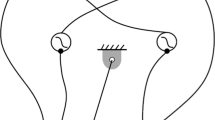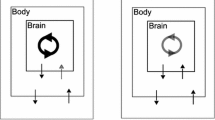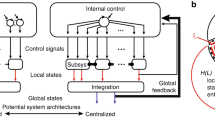Abstract
It has been hypothesized that sensory feedback is a critical component in determining the functionality of a central pattern generator. To test this, Yu and Thomas’s recent work Yu and Thomas (Biol Cybern 115(2):135–160, 2021) built a model of a half-center oscillator coupled to a simple muscular model with sensory feedback. They showed that sensory feedback increases robustness against external noise, while simultaneously expanding the potential repertoire of functions the half-center oscillator can perform. However, they show that this comes at the cost of robustness against internal noise.

Similar content being viewed by others
References
Ferrée TC, Lockery SR (1999) Computational rules for chemotaxis in the nematode C. elegans. J Comput Neurosci 6(3):263–277. https://doi.org/10.1023/a:1008857906763
Frigon A, Desrochers E, Thibaudier Y, Hurteau MF, Dambreville C (2017) Left-right coordination from simple to extreme conditions during split-belt locomotion in the chronic spinal adult cat. J Physiol 595(1):341–361. https://doi.org/10.1113/JP272740
Hennequin G, Vogels TP, Gerstner W (2014) Optimal control of transient dynamics in balanced networks supports generation of complex movements. Neuron 82(6):1394–1406. https://doi.org/10.1016/j.neuron.2014.04.045
Kuo AD (2002) The relative roles of feedforward and feedback in the control of rhythmic movements. Mot Control 6(2):129–145. https://doi.org/10.1123/mcj.6.2.129
Leonard JL (2000) Network architectures and circuit function: testing alternative hypotheses in multifunctional networks. Brain Behav Evol 55(5):248–255. https://doi.org/10.1159/000006659
Liu B, White AJ, Lo CC (2021) Augmenting flexibility: mutual inhibition between inhibitory neurons expands functional diversity. bioRxiv p. 2020.11.08.371179. https://doi.org/10.1101/2020.11.08.371179. https://www.biorxiv.org/content/10.1101/2020.11.08.371179v3
Lyttle DN, Gill JP, Shaw KM, Thomas PJ, Chiel HJ (2016) Robustness, flexibility, and sensitivity in a multifunctional motor control model. Biol Cybern 111(1):25–47. https://doi.org/10.1007/s00422-016-0704-8
Morris C, Lecar H (1981) Voltage oscillations in the barnacle giant muscle fiber. Biophys J 35(1):193–213. https://doi.org/10.1016/S0006-3495(81)84782-0
Nakahira Y, Liu Q, Sejnowski TJ, Doyle JC (2021) Diversity-enabled sweet spots in layered architectures and speed-accuracy trade-offs in sensorimotor control. Proc Natl Acad Sci 118(22):1098. https://doi.org/10.1073/pnas.1916367118
Neustadter DM, Herman RL, Drushel RF, Chestek DW, Chiel HJ (2007) The kinematics of multifunctionality: comparisons of biting and swallowing in Aplysia californica. J Exp Biol 210(2):238–260. https://doi.org/10.1242/jeb.02654
Seelig JD, Jayaraman V (2015) Neural dynamics for landmark orientation and angular path integration. Nature 521(7551):186–191. https://doi.org/10.1038/nature14446
Shaw KM, Lyttle DN, Gill JP, Cullins MJ, McManus JM, Lu H, Thomas PJ, Chiel HJ (2015) The significance of dynamical architecture for adaptive responses to mechanical loads during rhythmic behavior. J Comput Neurosci 38(1):25–51. https://doi.org/10.1007/s10827-014-0519-3
Shew WL, Yang H, Yu S, Roy R, Plenz D (2011) Information capacity and transmission are maximized in balanced cortical networks with neuronal avalanches. J Neurosci 31(1):55–63. https://doi.org/10.1523/JNEUROSCI.4637-10.2011
Su TS, Lee WJ, Huang YC, Wang CT, Lo CC (2017) Coupled symmetric and asymmetric circuits underlying spatial orientation in fruit flies. Nat Commun 8(1):139. https://doi.org/10.1038/s41467-017-00191-6
Yu SN, Crago PE, Chiel HJ (1999) Biomechanical properties and a kinetic simulation model of the smooth muscle I2 in the buccal mass of Aplysia. Biol Cybern 81(5):505–513. https://doi.org/10.1007/s004220050579
Yu Z, Thomas PJ (2021) Dynamical consequences of sensory feedback in a half-center oscillator coupled to a simple motor system. Biol Cybern 115(2):135–160. https://doi.org/10.1007/s00422-021-00864-y
Acknowledgements
Thank you to Youngmin Park, Belle Liu, Ching-Che Charng, and Chung-Chuan Lo for feedback on copy editing of the manuscript.
Author information
Authors and Affiliations
Corresponding author
Ethics declarations
Conflict of interest
The author declare that they have no conflict of interest.
Additional information
Communicated by Jean-Marc Fellous.
Publisher's Note
Springer Nature remains neutral with regard to jurisdictional claims in published maps and institutional affiliations.
Rights and permissions
About this article
Cite this article
White, A.J. Sensory feedback expands dynamic complexity and aids in robustness against noise. Biol Cybern 116, 267–269 (2022). https://doi.org/10.1007/s00422-021-00917-2
Received:
Accepted:
Published:
Issue Date:
DOI: https://doi.org/10.1007/s00422-021-00917-2




